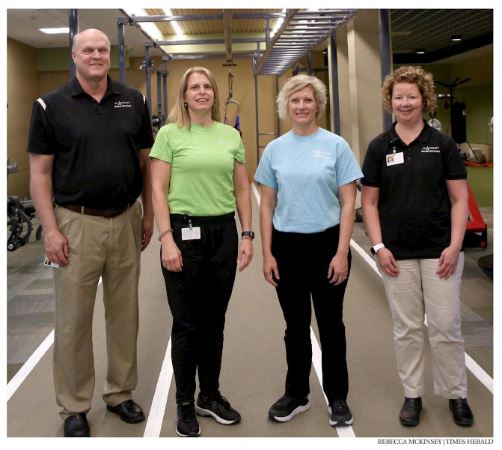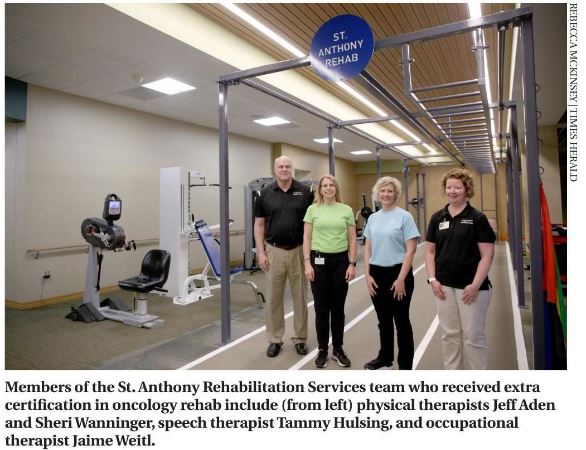
posted
on 6/9/2021
in
Features
By REBECCA MCKINSEY r.mckinsey@carrollspaper.com Carroll Times Herald, June 8, 2021 HealthView
After several of St. Anthony Regional Hospital’s Rehabilitation Services employees recently received additional certification, patients at the St. Anthony Cancer Center now can access specialized physical, occupational and speech therapy.
Rehabilitation therapists at St. Anthony decided to undertake the additional training to become certified in oncology rehabilitation as the cancer center was being built.
“We wanted to be part of the cancer-treatment team — doctors, radiation oncologists, nurses, surgeons — we’re part of the rehab team to help patients deal with the side effects of surgery, radiation and chemotherapy and improve quality of life,” said Jeff Aden, a physical therapist and director of the St. Anthony Rehabilitation Services department.
Four people from St. Anthony Rehabilitation Services received the specialized certification. Oncology rehabilitation, which tailors physical, occupational and speech therapies specifically to people with cancer, helps patients manage side effects from cancer treatment and maintain the abilities needed for their daily activities.
“Oncology rehabilitation offers a wide variety of therapies that are designed with the goal of helping patients to build strength, reduce stress, boost endurance, regain independence and maintain the energy needed to continue treatment and participate in daily activities,” states information from St. Anthony.
Following are details about the specific oncology rehabilitation services St. Anthony now offers:
— Occupational therapy (Jaime Weitl, OT): OT emphasizes activities of daily living or work, including bathing, dressing, eating, grooming, sleeping, socializing, shopping, leisure participation, home management and work activities, according to information from St. Anthony. OT helps patients manage and regain their range of motion. This therapy helps people better tolerate certain activities, rebuild muscle strength, manage limitations caused by scar tissue and more.
— Physical therapy (Sheri Wanninger, DPT, and Jeff Aden, DPT): PT helps patients regain and improve strength, balance, activity tolerance and mobility. It addresses activities such as walking, climbing stairs, getting out of chairs and other daily activities.
— Speech and language pathology/speech therapy (Tammy Hulsing, SLP): This type of therapy focuses on head and neck conditions, as well as conditions that affect speaking, swallowing and eating. Speech therapy also helps patients regain cognitive and memory abilities. For patients with head and neck cancers whose treatment affects mouth muscles, speech and language pathology can help patients relearn how to speak and swallow effectively, Aden said.
All three types of therapy offered through Oncology Rehabilitation Services help treat and prevent lymphedema, or swelling caused by excess fluid in the tissues, which often is experienced by people being treated for cancer. The therapies also address tightened tissues and scarring that can affect mobility, as well as heart issues, chronic fatigue and weakness, all potential side effects of cancer treatment.
Each of the therapists at St. Anthony who went through the oncology rehab training obtained additional advanced training in various areas: breast cancer for Weitl; pelvic and lower extremity cancers for Wanninger; chemo toxicity and cancer exercise management for Aden; and head and neck cancer for Hulsing. In addition to addressing common symptoms and side effects cancer patients experience, the training examined different drugs used to treat cancer and the way they can affect patients, Aden said.
As a whole, the combined services offered through St. Anthony’s Oncology Rehab Services can help patients with cancer who are having issues with walking, eating and swallowing, speaking and communication, fatigue, memory, peripheral neuropathy with pain and tingling in the hands and feet and tingling in the limbs, lymphedema and swelling, cardiac issues, incontinence, stiffness and decreased range of motion, difficulties completing daily-living activities, difficulties returning to work, and sexual health.
“The benefit of knowing those side effects is, if you can work with a patient early, you can alert them with those things to look for,” Aden said. “If it does happen, maybe they won’t be so concerned — ‘They told me this would happen’ — and we can discuss how to manage it.”
In the past, Rehabilitation Services didn’t always see patients until well into their cancer treatment, when the side effects had exacerbated and drastically affected mobility and movement.
“Some are so far deconditioned they could barely walk,” Aden said. “We wanted to see how we could help avoid things going that far.”
The coordination between Rehab Services and the cancer center means that patients can meet with rehab therapists for “prehab” before they begin their cancer treatment. This allows them to work with therapists to determine a baseline that can be used to measure later progress and to set rehab treatment goals after cancer treatment is complete.
The timing of rehab services — when therapy begins and how long it takes — depends on each patient and is determined through coordination with patients’ care teams. Depending on the course of the cancer treatment, care providers sometimes choose to have patients complete their cancer treatment and take a short break before transitioning into rehab services.
The timing of the therapy can be crucial, Aden said; if patients address side effects such as stiffness, swelling and scarring as they happen, rather than waiting, they can drastically improve mobility.
“If you let it get ahead of you, it can become a permanent problem,” he said.
And it doesn’t always take a long time or involve dozens of appointments — the rehab is tailored toward teaching people exercises and actions they can continue on their own at home, Aden said.
“These people are going through a lot, and we want to respect their time,” he said.
Once the overwhelming process of cancer treatment is complete, smaller effects come to the fore: not being able to sleep at night because of painful feet; being unable to raise an arm; having difficulty cooking.
There’s where Oncology Rehab Services comes in — working with patients to regain a measure of control during a time when they may feel out of control, Aden said.
“In rehab, we’re not going to help cure them from their cancer — we’re not doing treatment to treat cancer,” he said. “It’s more quality of life, being able to continue doing their normal activities.”

Filter
- cancer
- cancer center
- cancer rehab
- cancer rehab services
- cancer services
- cancer therapy
- oncology certified
- oncology rehab